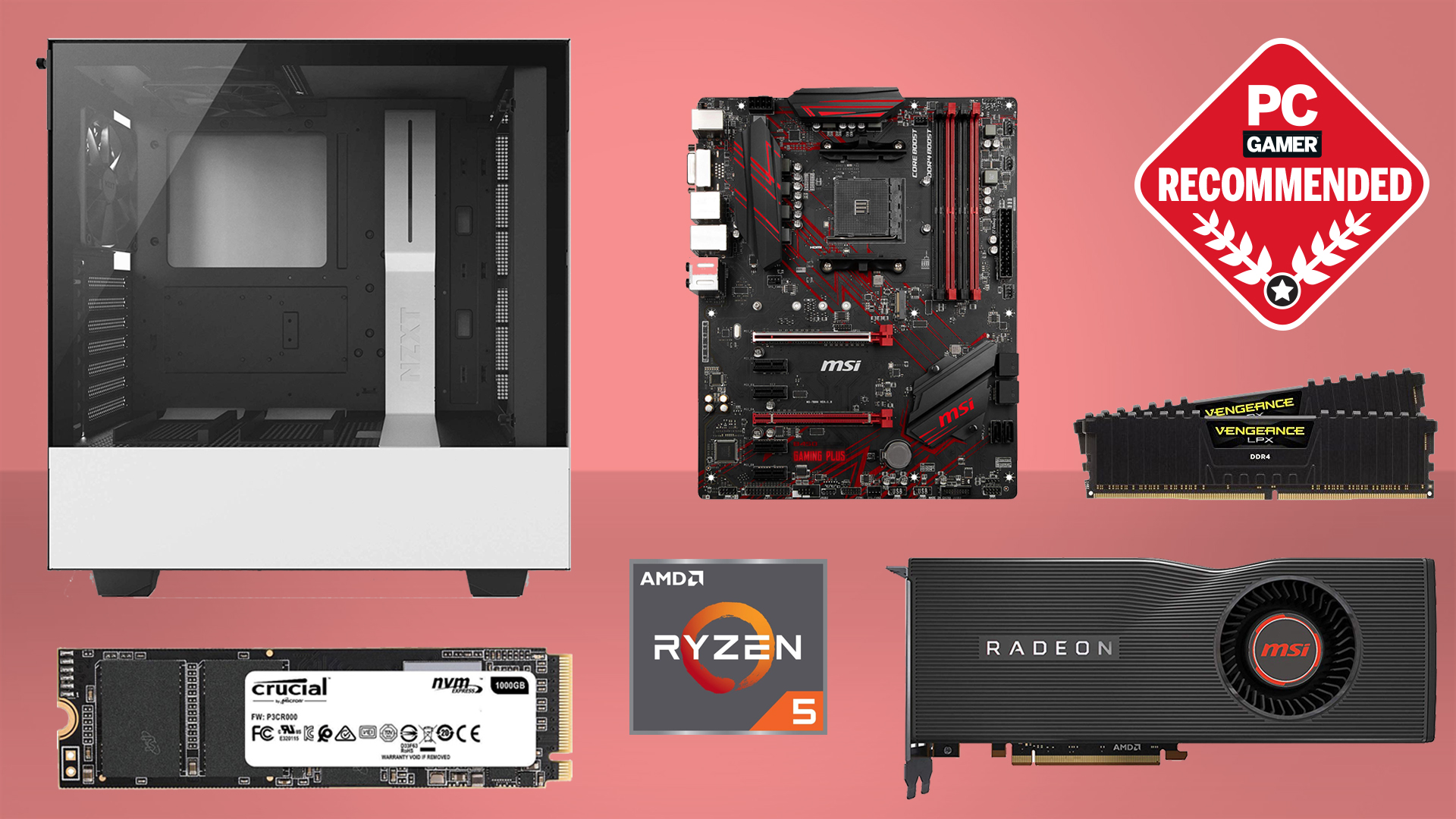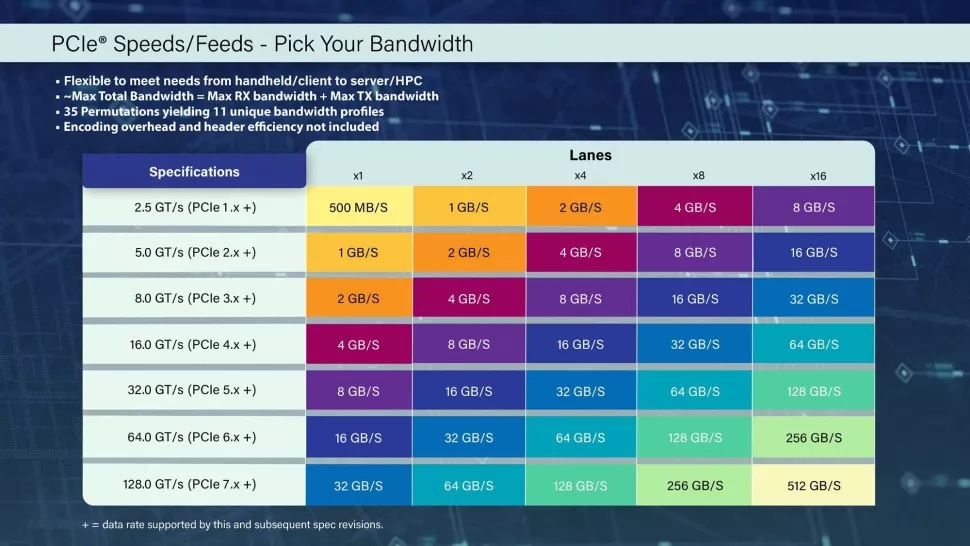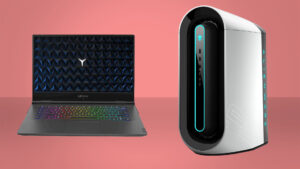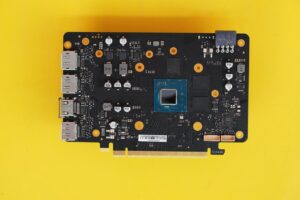PCI-SIG Developers Conference 2022 is underway in California. The PCI-SIG group is responsible for development of PCIe specifications, and today it announced that the next (realistically next-next) generation PCIe 7.0 specification is set to be released in 2025.
PCIe doubles in data rate and bandwidth every generation. This means PCIe 7.0 can deliver a maximum data rate up to 128GT/s. If we ignore overhead, PCIe 7.0 delivers up to 512GB/s of bi-directional throughput for a x16 connection. This compares to 32GB/s for a PCIe 3.0 x16 connection, 64GB/s for PCIe 4.0 and 128GB/s for PCIe 5.0. It's important to emphasise that these are bi-directional numbers.
The PCI-SIG developers are targeting PCIe 7.0 at the usual bandwidth craving suspects including AI, machine learning, data centres, HPC and quantum computing. How does 800G ethernet sound! But what does PCIe 7.0 mean for gamers?
Current generation 16x graphics cards don’t suffer much – if at all, when compared on PCIe 3.0 and PCIe 4.0 systems, but with faster GPUs, developing technologies and things like DirectStorage, there will be a need for higher bandwidth in the future. It's also a given that we’ll see more graphics cards make use of x4 or x8 connections.

Cel mai bun CPU pentru jocuri: Cele mai bune cipuri de la Intel și AMD
Cea mai bună placă de bază pentru jocuri: Plăcile potrivite
Cea mai bună placă grafică: împingătorul tău de pixeli perfect te așteaptă
Cel mai bun SSD pentru jocuri: Intră în joc înaintea celorlalți
A PCIe 7.0 x2 slot will offer as much bandwidth as a PCIe 4.0 x16 slot, just something to think about.
Faster PCIe connections are much more useful when it comes to NVMe SSDs, however. Already we’re seeing pre-production PCIe 5.0 drives close in on the 16GB/s (32GB/s bi-directional) theoretical limit of an x4 connection. This means a future PCIe 7.0 x4 drive could offer sequential transfer speeds of close to 64GB/s!
At these levels, sequential speeds seem almost irrelevant. As long as the random performance and latency of SSDs continues to improve, there’s no reason that a PCIe 7.0 x1 drive wouldn’t make an absolutely cracking gaming drive.
But can manufacturers let go of the marketing tactic highlighting 99999 MB/s sequential transfer speeds? Probably not.

It’s not all sunshine and roses, though. With higher throughput comes greater complexity. Electrical tolerances become tighter and that means more complicated motherboard designs and—you guessed it—higher prices. With PCIe 4.0 and 5.0 motherboards jumping upwards in price, and no respite in sight for current inflation levels, motherboards in the second half of this decade could carry some scary price tags.
There’s a lot of time to wait before PCIe 7.0 devices hit store shelves, however. PCIe 5.0 has yet to firmly establish itself, and PCIe 6.0 platforms and devices are a couple of years away at best. Still, it’s exciting to get a peek at the potential capabilities of PC’s in the years to come.
- "
- 7
- a
- Despre Noi
- peste
- înainte
- AI
- TOATE
- deja
- a anunțat
- deveni
- înainte
- CEL MAI BUN
- California
- capacități
- Carduri
- transporta
- Chips
- cum
- venire
- comparație
- tehnica de calcul
- Conferință
- conexiune
- Conexiuni
- continuă
- ar putea
- Cuplu
- credit
- Curent
- de date
- deceniu
- Oferă
- descriere
- modele
- Dezvoltatorii
- în curs de dezvoltare
- Dezvoltare
- Dispozitive
- conduce
- stabili
- captivant
- mai repede
- cu fermitate
- din
- viitor
- joc
- Gamerii
- jocuri
- generaţie
- generații
- unități de procesare grafică
- grafică
- mai mare
- grup
- superior
- Cum
- Totuși
- HTTPS
- imagine
- important
- îmbunătăţi
- Inclusiv
- inflaţiei
- Intel
- IT
- în sine
- învăţare
- nivelurile de
- LIMITĂ
- Lung
- maşină
- masina de învățare
- face
- Producătorii
- Marketing
- mijloace
- mai mult
- următor
- numere
- oferi
- Perfect
- performanță
- Platforme
- potenţial
- preţ
- Cuantic
- cuantic calcul
- eliberat
- responsabil
- set
- unele
- ceva
- specificație
- Specificaţii
- viteze
- Încă
- stoca
- soare
- sisteme
- direcționare
- Tehnologii
- lucruri
- debit
- timp
- astăzi
- top
- transfer
- In curs
- în sus
- utilizare
- aștepta
- Ce
- ani
- Ta












